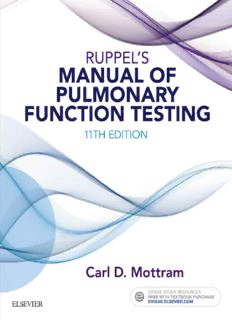
Ruppel’s Manual of Pulmonary Function Testing PDF
Preview Ruppel’s Manual of Pulmonary Function Testing
Ruppel's Manual of Pulmonary Function Testing ELEVENTH EDITION Carl D. Mottram, RRT, RPFT, FAARC Associate Professor of Medicine, Mayo Clinic College of Medicine, Rochester, Minnesota 2 Table of Contents Cover image Inside Front Cover Symbols and Abbreviations Used in Pulmonary Function Testing Title page Copyright Contributors/Reviewers Foreword Preface Distinctive features Changes to this edition Using this book Evolve ancillaries Acknowledgments 3 Chapter 1: Indications for Pulmonary Function Testing Pulmonary function tests Indications for pulmonary function testing Patterns of impaired pulmonary function Preliminaries to patient testing Test performance and sequence Summary Case study Self-assessment questions Entry-level Advanced Chapter 2: Spirometry Vital capacity Forced vital capacity, forced expiratory volume, and forced expiratory flow Flow-volume curve Peak expiratory flow Maximum voluntary ventilation Before- and after-bronchodilator studies Summary Case studies Self-Assessment Questions Entry-level Advanced 4 Chapter 3: Diffusing Capacity Tests Carbon monoxide diffusing capacity Summary Case studies Self-Assessment Questions Entry-level Advanced Chapter 4: Lung Volumes, Airway Resistance, and Gas Distribution Tests Lung volumes: functional residual capacity, residual volume, total lung capacity, and residual volume/total lung capacity ratio Airway resistance and conductance Gas distribution tests: single-breath nitrogen washout, closing volume, and closing capacity Multiple breath nitrogen washout, lung clearance index, and phase III slope analysis Summary Case studies Self-Assessment Questions Entry-level Chapter 5: Ventilation and Ventilatory Control Tests Tidal volume, rate, and minute ventilation Respiratory dead space and alveolar ventilation Ventilatory response tests for carbon dioxide and oxygen 5 High-altitude simulation test Summary Case studies Self-Assessment Questions Entry-level Advanced Chapter 6: Blood Gases and Related Tests pH Carbon dioxide tension Oxygen tension Hemoximetry Pulse oximetry Capnography Shunt calculation Summary Case studies Self-assessment questions Entry-level Advanced Chapter 7: Cardiopulmonary Exercise Testing and Field Tests Field tests Six-minute walk test (6MWT) reference set Exercise protocols 6 Exercise workload Cardiovascular monitors during exercise Ventilation during exercise Oxygen consumption, carbon dioxide production, and respiratory exchange ratio during exercise Exercise blood gases Cardiac output during exercise Summary Case studies Self-assessment questions Entry-level Advanced Chapter 8: Pediatric Pulmonary Function Testing Infant, toddler, and preschool pulmonary function testing Spirometry Diffusion capacity Lung volumes Bronchoprovocation challenges Exhaled nitric oxide standards for testing What the future holds for pediatric pulmonary function laboratories Summary Case studies Self-assessment questions Entry-level 7 Advanced Chapter 9: Bronchoprovocation Challenge Testing Bronchoprovocation challenge testing Summary Case studies Self-assessment questions Entry-level Advanced Chapter 10: Specialized Test Regimens Respiratory muscle strength testing Exhaled nitric oxide Forced oscillation technique Preoperative pulmonary function testing Pulmonary function testing for social security disability Metabolic measurements: indirect calorimetry Summary Case studies Self-assessment questions Entry-level Advanced Chapter 11: Pulmonary Function Testing Equipment Volume-displacement spirometers 8 Flow-sensing spirometers Peak flowmeters Body plethysmographs Breathing valves Pulmonary gas analyzers Blood gas analyzers, oximeters, and related devices Computers for pulmonary function testing Summary Self-assessment questions Entry-level Advanced Chapter 12: Quality Systems in the Pulmonary Function Laboratory Quality manual Quality system essentials Path of workflow Summary Case studies Self-assessment questions Entry-level Advanced Chapter 13: Reference Values and Interpretation Strategies Selecting and using reference values Establishing what is abnormal 9 Pulmonary function testing interpretation, “bringing it all together” Interpretation algorithm Summary Case studies Self-assessment questions Entry-level Advanced Appendix A: Answers to Self-Assessment Questions Chapter 1, Indications for pulmonary function testing Chapter 2, Spirometry Chapter 3, Diffusing capacity tests Chapter 4, Lung volumes, airway resistance, and gas distribution tests Chapter 5, Ventilation and ventilatory control tests Chapter 6, Blood gases and related tests Chapter 7, Cardiopulmonary exercise testing and field tests Chapter 8, Pediatric pulmonary function testing Chapter 9, Bronchoprovocation challenge testing Chapter 10, Specialized test regimens Chapter 11, Pulmonary function testing equipment Chapter 12, Quality systems in the pulmonary function laboratory Chapter 13, Reference values and interpretation strategies Glossary 10
Description: